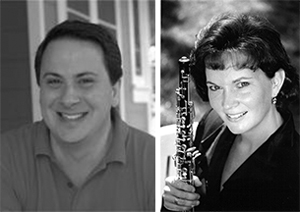by Mike Telin

On Thursday, November 14 beginning at 7:30 pm in Akron’s First Congregational Church, Guy Victor Bordo will lead Akron Baroque in a concert featuring Thomas Moore and Danna Sundet, in Vivaldi’s Concerto for Two Oboes in C, RV 534 and Albinoni’s Concerto for Two Oboes, Op.7, No. 11. The concert also includes works by Corelli, Locatelli and Marcello. (See our concert listing page for program details)
“I’m not a scholar, but the baroque composers were also the first to put the instrument into the opera orchestra,” Sundet adds. “It went from being an outdoor instrument like the shawm, to an indoor instrument.” Moore points out that J.S. Bach used the oboe many times as an obbligato instrument with the voice, and that Handel often paired it with the upper strings in his operas and oratorios to provide extra brilliance to the orchestral sound.
Sundet calls the Albinoni concerto a “simple, charming piece” and says that she has played it on tours of Brazil and Norway with her husband, trumpeter Erik Sundet. “There are many double concertos by Albinoni and we first learned about them because the famous French trumpet player Maurice André recorded many of them with an oboist friend.” She adds that she looks forward to playing the piece with two oboes.
Like many of his concertos, Vivaldi composed his double concerto for the female music ensemble of the Ospedale della Pietà, “but we won’t be playing from behind a screen and we’ll be visible to everyone,” jokes Moore, who notes that because of the popularity of the Historical Performance movement, were we to be transported back in time, the performances of these works would “sound pretty familiar to our ears.” Moore adds, “one thing we struggle with on modern oboes is stamina, just to be able to play these incredibly long passages with no breaks to breathe.”
Published on ClevelandClassical.com November 12, 2013
Click here for a printable version of this article.



